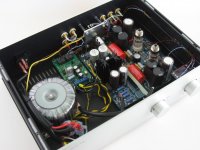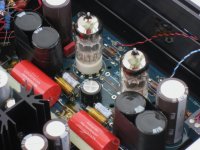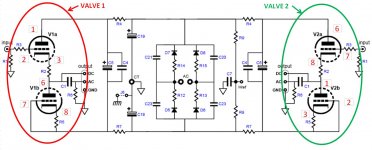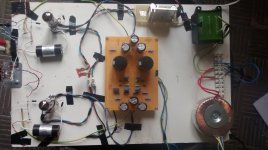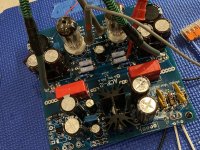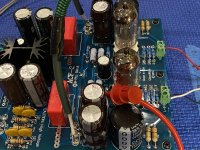This is how the board with the two extra caps (per channel) looks in real life. Additional photos are in my blog post.
Attachments
Last edited:
alexcp,
the muting relay it's necessary in the preamp or only in power amp?
The relays of delay pcb, they act on the otput RCA?
Toroidal 115-0-115 secondary VAC It's OK for this preamp? Obviously it is necessary another transformer 12v for filaments and eventually for delay pcb.
the muting relay it's necessary in the preamp or only in power amp?
The relays of delay pcb, they act on the otput RCA?
Toroidal 115-0-115 secondary VAC It's OK for this preamp? Obviously it is necessary another transformer 12v for filaments and eventually for delay pcb.
The muting relay shorts the output RCAs when powered off and un-shorts them in a few seconds after power-on, thus protecting the power amp from preamp transients. In the power amp, a muting relay protects speakers from the transients of the power amp. Generally, you need both, but in the specific case of ACF, having the muting relay in the preamp is probably not critical.
My transformer runs at 130-0-130VAC with ~160V or so rails after the rectifier. You can probably use a 115-0-115VAC secondary, adjusting R4, R7, and R12-R15 to get the right voltages for the triodes.
My transformer runs at 130-0-130VAC with ~160V or so rails after the rectifier. You can probably use a 115-0-115VAC secondary, adjusting R4, R7, and R12-R15 to get the right voltages for the triodes.
This topic has been discussed here in the forum in the past, and many people have found that FREDs sound better. All discussions I have seen was based on listening impressions and/or hand waving, but not on any kind of measurements. (If you have seen relevant measurements or waveforms, please post a link!)
FREDs are, effectively, better Schottky diodes with lower voltage drop and lower leakage current. None of these is important when rectifying 50/60Hz. The claim that soft/fast/ultafast recovery reduces high frequency noise is moot, as the current via any rectifier, standard or FRED, is already nonlinear, rich in high frequency components, thus needs a snubber (which BTW is included on the ACF-2 board). Adding a parallel capacitor to an ultrafast diode to make it slower sounds like waste to me. I would much rather invest in a suitable choke. Even better, I would make the rectifier work into a choke-input filter.
FREDs are, effectively, better Schottky diodes with lower voltage drop and lower leakage current. None of these is important when rectifying 50/60Hz. The claim that soft/fast/ultafast recovery reduces high frequency noise is moot, as the current via any rectifier, standard or FRED, is already nonlinear, rich in high frequency components, thus needs a snubber (which BTW is included on the ACF-2 board). Adding a parallel capacitor to an ultrafast diode to make it slower sounds like waste to me. I would much rather invest in a suitable choke. Even better, I would make the rectifier work into a choke-input filter.
I've tried my ACF-2 with FRED.
The sound is more aggressive and the image is smaller and less realistic. I did not like it at all, in fact after one day I put back the much mistreated 1N4007 and ..... the magic returned as I remembered it.
The sound returned smooth and warm and the image bigger and more realistic.
This is my brief and personal experience with these diodes and this preamplifier demonstrates that "better" is not always better.
The sound is more aggressive and the image is smaller and less realistic. I did not like it at all, in fact after one day I put back the much mistreated 1N4007 and ..... the magic returned as I remembered it.
The sound returned smooth and warm and the image bigger and more realistic.
This is my brief and personal experience with these diodes and this preamplifier demonstrates that "better" is not always better.
Thank you for sharing - it is an interesting observation.
BTW, Nelson Pass in his 2001 article on power supplies wrote:
BTW, Nelson Pass in his 2001 article on power supplies wrote:
Yeah, sure, rectifiers are important, after all, the AC has to get converted to DC, but I don't like the fast recovery types that some audiophiles have raved about. Fast recovery means that they withstand many amps and volts in a tenth of a few nano-seconds, something we don't see very often on the old 60 Hz AC line. They are essential element in switching power supplies, but for regular "linear" power supplies, I much prefer SLOW diodes, and we create them by placing small capacitor circuits across the diodes, which greatly reduces radiated noise.
Very interesting indeed... and you had got me really interested in this possible upgrade. Now, I am reconsidering this, especially since I just finished restoring an old Marantz 1060 and I was thinking about changing the diodes on the power amp bridge rectifier - maybe leave it as is.
Hello Fellas,
I recently picked up an ACF-2 9-pin board from the swap meet and then came across this thread before I started assembling it. I also noticed there are a few discrepancies between the build guide and the actual pcb, no mention of C2, C6, C7, C24 and 4-leg bridge rectifier???
I want to say Thank You to all of you that contributed to ironing out the details to get this board working hum free. I went ahead and implemented the mods right from the beginning. I’m using a pair of 470uF, 200v electrolytic caps at C4 and matched the capacitors for C18/C19, R4/R7 are 3K3 ohm resistors. Heater and B+ voltages are within specs.
Just applied a signal using an iPhone as a source and I’m happy to say the ACF-2 is extremely quiet, I can’t hear any hum/noise with my ear right up to the front of my 84dB test speakers.
Since this board has turned out better than expected, I will get this into a chassis with selection and volume control.
Thank you All!!
Cheers,
Vunce
I recently picked up an ACF-2 9-pin board from the swap meet and then came across this thread before I started assembling it. I also noticed there are a few discrepancies between the build guide and the actual pcb, no mention of C2, C6, C7, C24 and 4-leg bridge rectifier???
I want to say Thank You to all of you that contributed to ironing out the details to get this board working hum free. I went ahead and implemented the mods right from the beginning. I’m using a pair of 470uF, 200v electrolytic caps at C4 and matched the capacitors for C18/C19, R4/R7 are 3K3 ohm resistors. Heater and B+ voltages are within specs.
Just applied a signal using an iPhone as a source and I’m happy to say the ACF-2 is extremely quiet, I can’t hear any hum/noise with my ear right up to the front of my 84dB test speakers.
Since this board has turned out better than expected, I will get this into a chassis with selection and volume control.
Thank you All!!
Cheers,
Vunce
Attachments
- Status
- This old topic is closed. If you want to reopen this topic, contact a moderator using the "Report Post" button.
- Home
- Amplifiers
- Tubes / Valves
- Glassware ACF-2 Aikido hum problem
